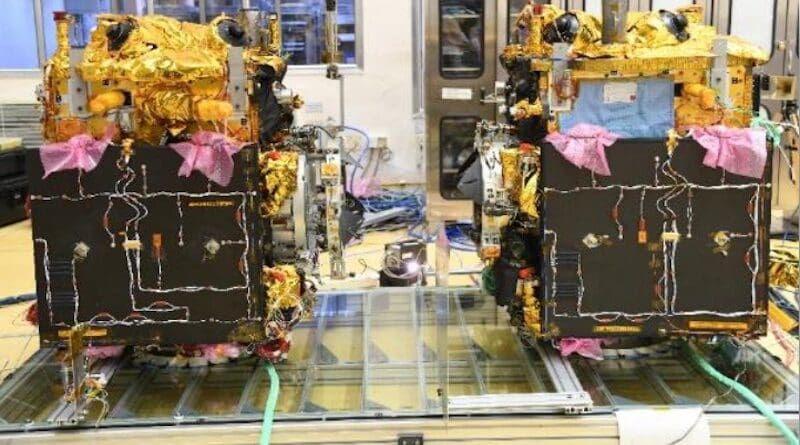10 Times Faster Than A Bullet: Mastering Of Orbital Alignment Dynamics For SpaDEx Docking – Analysis

SpaDEx Chaser (SDX01) and Target (SDX02) spacecrafts during testing. Photo Credit: Indian Space Research Organisation (GODL-India), Wikipedia Commons
India is gearing up for an important step in its space journey. On December 30 this year, ISRO will launch the Space Docking Experiment (SpaDEx) using the PSLV-C60 rocket. The launch is scheduled from Sriharikota for 9:58 PM (IST). This mission is a significant milestone, as it will demonstrate India’s ability to dock two spacecraft in orbit, a key technology for future space missions.
Docking is the process of connecting two satellites in space after carefully aligning them. This technology is essential for future missions that ISRO plans to undertake—such as Chandrayaan–4 and building India’s own space station, the Bharatiya Antariksh Station.
Mission Overview and Goals
In the SpaDEx mission, two satellites—SDX01 (called Chaser) and SDX02 (called Target)—will perform a series of important tasks. First, they will align themselves in the same orbit and then, gradually, move closer to each other. Once close enough, they will connect, share electrical power and then separate again. After separating, the payload on both satellites will continue to operate for the next two years.
A payload is the main equipment, or set of instruments, on a satellite or spacecraft that performs the mission’s purpose, such as cameras, sensors, or communication devices used for research or specific tasks.
India’s reliable Polar Satellite Launch Vehicle (PSLV-C60) will carry the SDX01 and the SDX02, each weighing 220 kilograms. These satellites will be placed in a 470-kilometre low-Earth (circular) orbit (LEO). After being placed in the targeted orbit, the rocket will give the two satellites a slight difference in speed. This difference will cause the satellites to gradually move apart, creating a distance of about 10 to 20 kilometres between them within a day.
The propulsion system on the Target satellite will be used to stop the two satellites from moving farther away from each other. This means both satellites will keep moving at the same speed while staying 20 kilometres apart. This phase is called the ‘far rendezvous’. Rendezvous means two objects meeting—or coming close together—in space, often after starting from different positions or paths.
Coming to speed, the two satellites will be traveling at an incredible 28,800 kilometres per hour—about 36 times faster than a commercial airplane or 10 times faster than a bullet. To safely dock, the Chaser satellite will slowly approach the Target satellite, step by step, carefully reducing the distance between them. The approach will follow a sequence, closing in gradually from 5 kilometres to 1.5 kilometres, then to 500 metres, 225 metres, 15 metres, 3 metres—finally docking.
Using special thrusters and advanced sensors, their relative speed will also be reduced to almost zero—around 0.036 kilometres per hour, or just 10 millimeters per second—ensuring a smooth and safe connection. After the satellites connect, they will test transfering electrical power between them. They will also show how both satellites can be controlled as a single unit. Once these tests are complete, the satellites will separate and begin working on their individual tasks using their onboard equipment.
The Chaser satellite is equipped with a high-resolution camera, which is like a smaller version of a surveillance camera. The Target satellite has a multi-spectral device to monitor natural resources and natural vegetation. It also has a radiation monitor to study space radiation and collect data for future use.
Since the satellites are small and lightweight, docking them is more difficult. It needs much greater precision compared to docking larger spacecraft because even tiny mistakes can have a bigger impact.
Mission Wants to Achieve…
This mission, happening at year-end, will achieve many things for the first time. The satellites will use advanced new technologies, including a special docking system and a set of sensors that help them move closer carefully and connect without colliding. They will also use a unique navigation system that calculates their positions and movements in orbit with high accuracy, ensuring everything works smoothly.
So far, only Russia, the US and China have successfully developed this advanced technology and none of them shares the detailed process behind it.
Apart from the docking experiment, the PSLV-C60 rocket will also carry 24 small payloads on its fourth stage, known as PSLV Orbital Experimental Module-4 (POEM-4). These will be activated after the two main satellites are released into space. Of the 24 payloads, 14 are developed by ISRO’s own teams. The remaining 10 come from non-government organizations, including universities and start-ups.
Karnataka’s Role in SpaDEx:
Blend of Academia/Startups
The SpaDEx mission highlights Karnataka’s significant contributions to space technology, with three of the 10 non-government payloads provisioned from the state. These payloads, developed by academic institutions and start-ups, showcase innovation and a commitment to advancing space exploration.
- RVSat-1: Created by students and researchers at RV College of Engineering, Bengaluru, this experiment studies how a gut bacterium—Bacteroides thetaiotaomicron—grows in space. Understanding this can help improve astronaut health, developing better antibiotics and creating recycling systems for future long-duration space missions.
- BGS ARPIT: Designed by SJC Institute of Technology, Chickballapur, this payload works as a transmitter that sends messages, including audio, text and images, from the satellite to Earth using FM signals and the VHF band. This technology supports amateur radio services across the globe.
- SJC Institute of Technology is a renowned engineering college established in 1986. Located near Bengaluru, it is managed by the Sri Adichunchanagiri Shikshana Trust (R.), which operates under the blessings of Jagadguru Sri Sri Sri Dr Balagangadharanatha Maha Swamiji and the guidance of Jagadguru Sri Sri Sri Dr Nirmalanandanatha Maha Swamiji.
- RUDRA 1.0 HPGP Payload: Developed by Bellatrix Aerospace Pvt. Ltd, Bengaluru, this payload demonstrates a cutting-edge green propulsion system that is both efficient and environment-friendly.
Contributions from these Karnataka-based institutions and start-ups underscore the state’s growing prominence in India’s space exploration efforts. The combination of academic research and entrepreneurial innovation is helping push the boundaries of what is possible in space technology.

Girish Linganna is a Defence, Aerospace & Political Analyst based in Bengaluru. He is also Director of ADD Engineering Components, India, Pvt. Ltd, a subsidiary of ADD Engineering GmbH, Germany. You can reach him at: girishlinganna@gmail.com
No comments:
Post a Comment